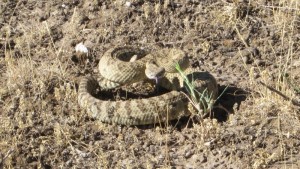On a recent Trek I ran into a rattlesnake…almost
As a result I did a short video on our YouTube channel as a reminder check it out here
Snake Bites
According to the CDC, about 8,000 snake bites occur in the United States each year. Even a bite from a so-called “harmless” snake can cause infection or allergic reaction in some people. For maximum safety, treat all snake bites as if they were venomous and get to a hospital emergency room as quickly as possible, especially if you are unsure of the exact type of snake responsible for the bite. With the correct treatment (or antivenin), severe illness and/or death can be prevented. (Antivenin, also called antivenom, is an antitoxin specific to the venom of a particular animal or insect).
People who frequent wilderness areas, camp, hike, picnic, or live in snake-inhabited areas should be aware of the potential dangers posed by venomous snakes. These people should:
- Know how to identify venomous snakes.
- Have access to transportation and medical assistance in case of emergency.
- Be aware that snakes are more active during warmer months.
What snakes are venomous?
The most common venomous snake bites are caused by the following snakes:
- Pit vipers–rattlesnakes, copperheads, and cottonmouth (water moccasin) snakes
- Coral snakes
Rattlesnake bites cause most of the venomous bites in the US. Coral snakes and imported exotic snakes cause a much smaller number of snake bites.
What are the symptoms of venomous bites?
The following are the most common symptoms of venomous snake bites. However, each individual may experience symptoms differently, and some may not have symptoms for a period of time. In addition, different snakes have different types of venom, so the symptoms may differ. Symptoms may include:
- Bloody wound discharge
- Fang marks in the skin and swelling at the site of the bite
- Severe localized pain
- Discoloration, such as redness and bruising
- Enlarged lymph nodes in the area affected
- Diarrhea
- Burning
- Convulsions
- Fainting
- Dizziness
- Weakness
- Blurred vision
- Excessive sweating
- Fever
- Increased thirst
- Loss of muscle coordination
- Nausea and vomiting
- Numbness and tingling, especially in the mouth
- Rapid pulse
- Altered mental state
- Shock
- Paralysis
- Breathing difficulties
The symptoms of a venomous snake bite may resemble other medical conditions or problems. Always consult your physician for a diagnosis.
Treatment for snake bites:
Call for emergency assistance immediately if someone has been bitten by a snake. Responding quickly in this type of emergency is crucial. While waiting for emergency assistance:
- Wash the bite with soap and water.
- Immobilize the bitten area and keep it lower than the heart.
- Cover the area with a clean, cool compress or a moist dressing to minimize swelling and discomfort.
- Monitor breathing and heart rate.
- Remove all rings, watches, and constrictive clothing, in case of swelling.
- Note the time of the bite so that it can be reported to an emergency room physician if needed.
- If possible, try to remember to draw a circle around the affected area and mark the time of the bite and the initial reaction. If you are able, redraw the circle around the site of injury marking the progression of time.
- It is helpful to remember what the snake looks like, its size, and the type of snake if you know it, in order to inform the emergency room staff.
- Do not apply a tourniquet.
- Do not attempt to suck the venom out.
Preventing snake bites:
Some bites, such as those inflicted when you accidentally step on a snake in the woods, are nearly impossible to prevent. However, there are precautions that can reduce your chances of being bitten by a snake, including the following:
- Leave snakes alone. Many people are bitten because they try to kill a snake or get too close to it.
- Stay out of tall grass unless you wear thick leather boots and remain on hiking paths as much as possible.
- Keep hands and feet out of areas you cannot see. Do not pick up rocks or firewood unless you are out of a snake’s striking distance.
- Be cautious and alert when climbing rocks.
Above information courtesy of University of Utah Health Care



